Bike Racks: Which One is the Best Choice?
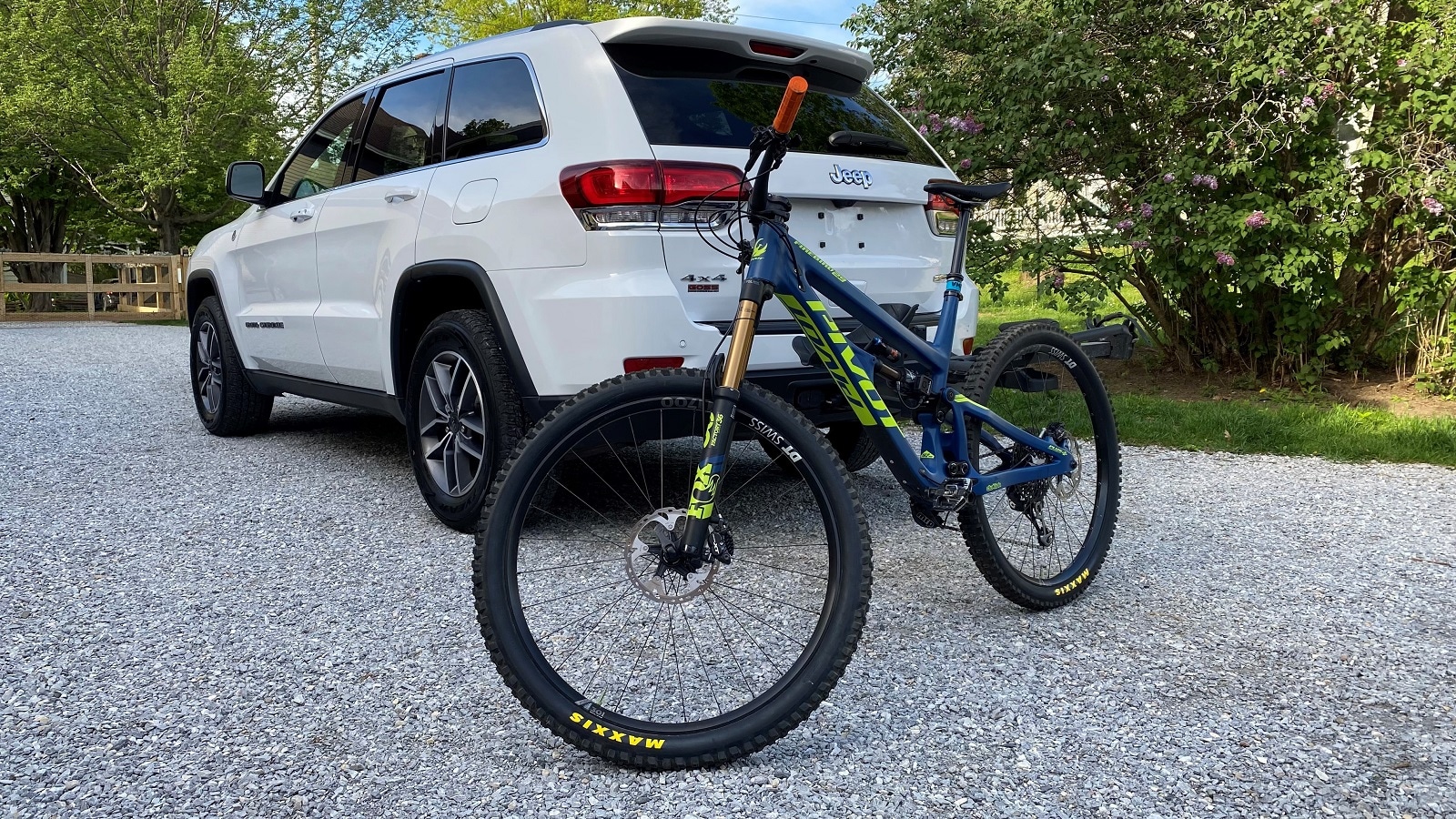
With bike racks for vehicles available in five different types, it’s hard to imagine which type you need. Selections include hitch racks, roof racks, trunk racks, truck bed racks, and spare tire racks. Typically, two or three kinds of bike racks will fit a cyclist’s vehicle, with roof and hitch being the most common.
The kind of bike you ride may impact the type of racks your car can handle. For instance, trunk and hitch bike racks that mount to the frame may have interference issues on full-suspension mountain bikes. Road bikes and hardtail mountain bikes offer more room inside the frame and should fit on any bike rack.
Bike racks can cost less than $100 and exceed $1,000 for a top-of-the-line version with space for four. Some bike racks offer integrated locks that protect your bike from thieves when you park your vehicle. While you can lock your bike to a trunk bike rack, there is no good way to lock the bike rack to the car. A pair of scissors or a knife could make short work of the bike rack mounting straps if a nefarious character decides they want a new bicycle.
In this story, Kelley Blue Book will cover all options for hauling your bikes, provide expert tips, and more. Read on to know which one will work best for your needs.
Bike Racks Explained:
But First, Some Background
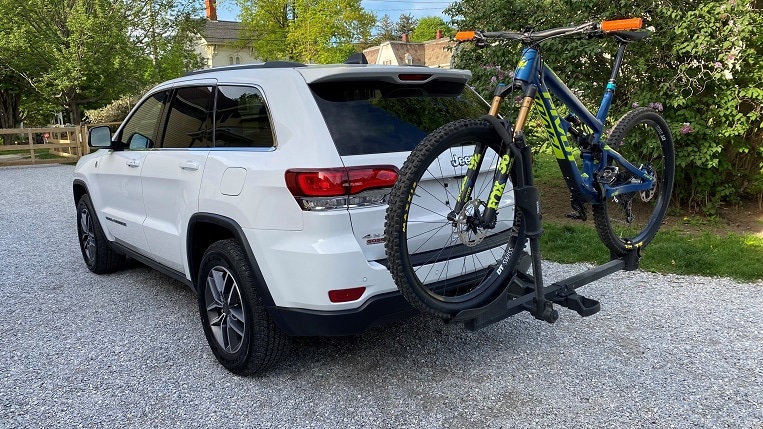
Many of us became interested in BMX biking early, long before we started mountain biking. Thankfully, BMX bikes are considerably smaller than mountain bikes and can easily be transported inside a hatchback or sedan. Fitting a mountain bike inside a car, however, usually involves removing the wheels and carefully placing everything inside a moving blanket to keep any grease or parts from staining or tearing the interior. After a while, the car’s interior may get damaged, or you might grow tired of disassembling the bike and carefully loading and unloading each time you want to ride.
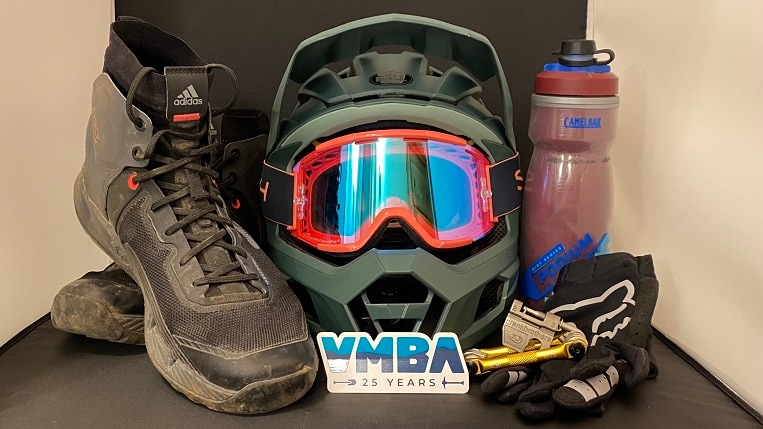
Once the seemingly inevitable happens, you may find yourself in the market for a bike rack. The experience gained using different styles of bike racks throughout the years and speaking with Vermont Mountain Bike Association members has given us valuable insight into what makes a great bike rack.
Types of Bike Racks
There are five different bike rack types available, and each one offers advantages and disadvantages. What remains true across all types of bike racks is that carrying more than two bikes can get expensive. The cost to add additional bike mounts to a popular hitch bike rack is $239 per mount and $40 for two wheel locks. Carrying four bikes on a trailer-mounted bike rack can easily exceed $1,000. Although this seems like a lot of money to spend on a bike rack, it’s essential to consider the value of bikes and that some mountain bikes can cost more than a used car.
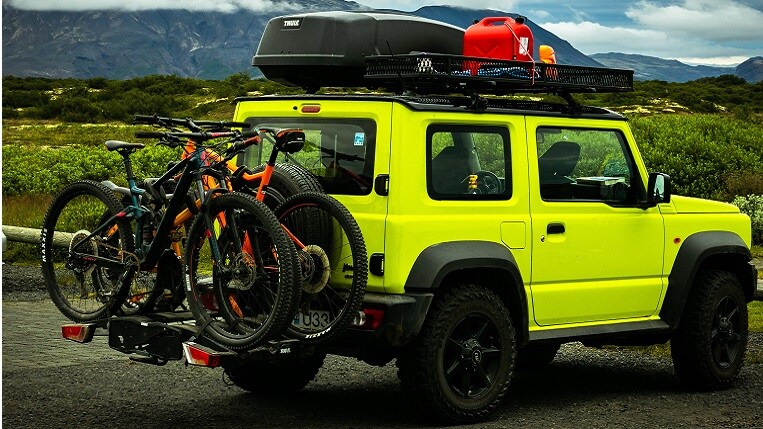
Hitch Bike Racks
If you’re an avid cyclist and plan to take frequent rides, most find that a hitch bike rack works best. Hitch-mounted bike racks allow for the easiest loading and unloading of bikes. They come in two varieties that support the bicycle by the wheels or the frame. You will find hitch-mount bike racks that support the tires, keep your equipment more stable, won’t scratch the bike frame, and work compatibly with full-suspension mountain bikes.
Pros
- Easy loading and unloading of bikes
- Can be swapped from vehicle to vehicle
- Some models support the bike by the wheels
Cons
- Can block access to the trunk when bikes are loaded
- Extends the length of the vehicle when in use
- High-end models are expensive
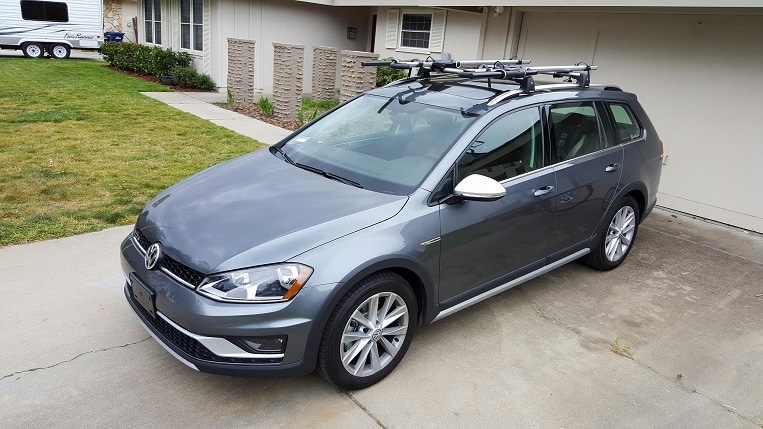
Roof Bike Racks
Roof-mount bike racks offer a great deal of flexibility and are an excellent choice for an outdoor enthusiast that needs to transport various types of gear. If your car comes equipped with roof crossbars, adding a bike rack on top can be a relatively cost-effective option. The crossbars can also mount kayaks, skis, snowboards, and cargo carries. It can be a bit more challenging to load and unload bikes from the rack on tall vehicles when compared to a hitch bike rack.
Pros
- Versatile system that can be used to carry other equipment
- Models that mount to the bike fork stay secure
- Doesn’t impact the ability to access the trunk
Cons
- Extends the height of the vehicle by a few feet
- Mounting a full-suspension mountain bike (30 pounds or more) can be difficult
- Increased wind noise and resistance
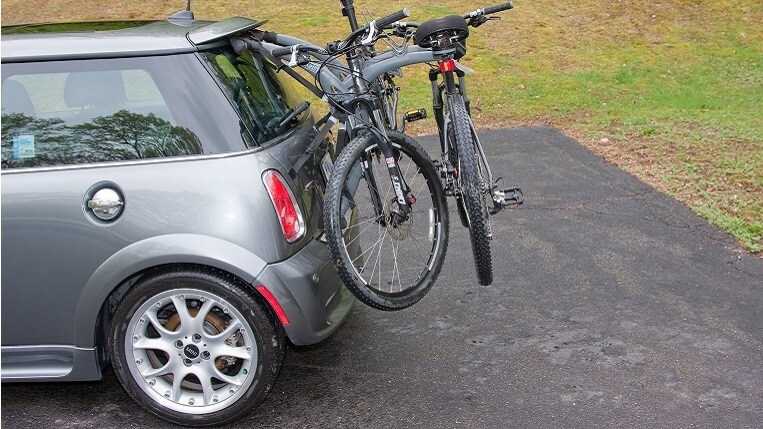
Trunk Bike Racks
Typically, the most affordable and compact bike racks are trunk mounted. Trunk-mount bike racks are best suited for sedans, and they can work on some hatchbacks. Be cautious of using a trunk bike rack on hatchbacks with spoilers since they aren’t usually designed to support any weight.
Expert Tip: Be sure to add scratch protection on the mounting clips to prevent paint scratches. If the scratches become too severe, you can repair the damage by performing a paint correction. Applying a piece of paint protection film to the backside of the mounting hooks will help prevent paint scratches, scuffs and scrapes. PPF is a vinyl film typically applied to car paint. Using the PPF will yield the same results without covering the entire trunk with protective film. You can also purchase quite a few specialty products online by searching for “trunk bike-rack protectors.”
Pros
- Cost is usually the lowest of all rack types
- Lightweight and easy to mount to the vehicle
- Can be swapped from vehicle to vehicle
Cons
- Blocks access to the trunk regardless of the bikes mounted
- Minimal built-in security features
- Can easily scratch or remove paint from the vehicle
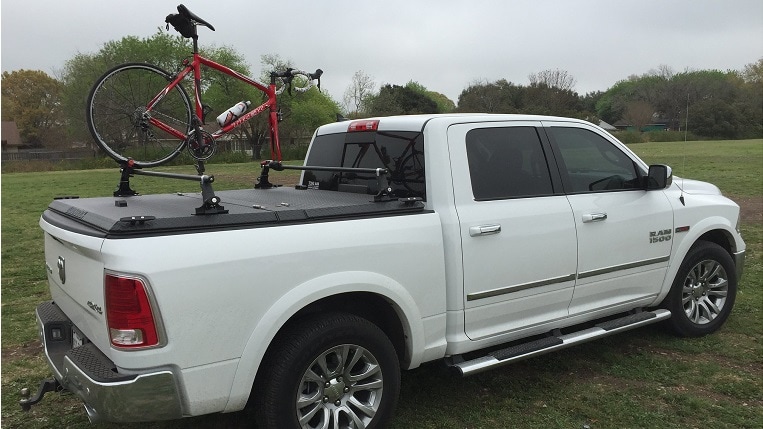
Truck Bed Racks
You can mount bikes to pickup truck beds in two ways. You can secure some racks to the truck’s bed, and there are tailgate pads that the bikes rest on for easy removal. Truck-bed mounts cost more, but they offer more security when transporting the bikes or if you have to leave them unattended. Tailgate pads, or thick material that folds over the back of the vehicle and keeps it protected, can be helpful if you use the truck to shuttle bikes to the top of the trail because of the easy loading and unloading.
Pros
- Quick loading and unloading of bikes
- Bed mounts don’t drastically increase the vehicle footprint
- Tailgate pads allow for carrying five or more bikes
Cons
- Some models aren’t compatible with tonneau covers (or what covers the bed of a pickup)
- Large bikes may not fit in truck beds shorter than six feet.
- Tailgate pads can scratch or remove paint from the vehicle
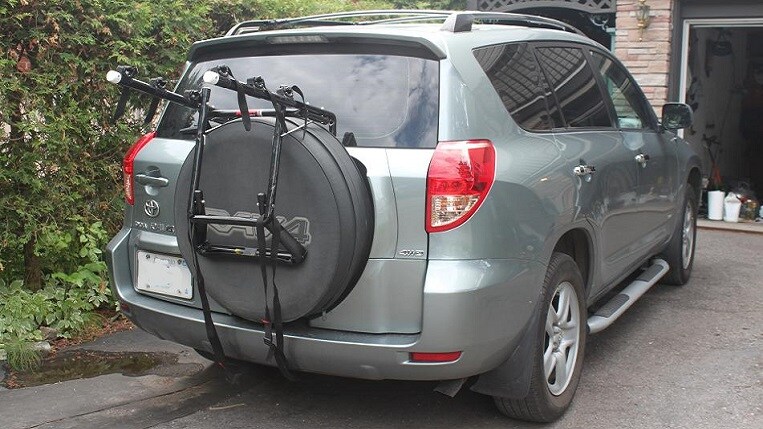
Spare Tire Bike Racks
Not many vehicles feature spare tires mounted on the back. If you own a Jeep Wrangler, Ford Bronco, or Toyota FJ Cruiser, then a spare-tire bike rack is an option to consider. Most spare-tire mounts support the bike by the frame, but a select few support the bike by the wheels. The racks that support the wheels only tend to have a limited wheelbase of 48 inches, and some mountain bikes can exceed a 50-inch wheelbase. A spare-tire bike mount could be the right choice if you use a trailer hitch to tow a trailer or hold a cargo carrier.
Pros
- Cost is usually less expensive than hitch bike racks
- Most models don’t impact trunk access
- Frees up the trailer hitch for towing or hauling
Cons
- Not as secure as a hitch or roof bike rack
- Mounting straps may come loose on longer and rougher drives
- May not be compatible with larger wheels and tires
What Bike Rack Fits My Vehicle?
The type of vehicle you drive may impact the bike rack you buy. Hitch- and roof-mount bike racks will be the most versatile as they are compatible with the broadest range of vehicle body styles. If your vehicle doesn’t boast roof crossbars or a trailer hitch, then the cost to install specific bike racks will increase quite a bit.
Cars
Cars offer a few bike rack options and usually require the installation of a trailer hitch or roof bars, which increases the cost significantly. A trunk bike rack might be the best option if you’re on a tight budget. However, if your vehicle and budget allow for a hitch or roof bike rack, they are the superior option for transporting bikes.
- Hitch bike racks
- Roof bike racks
- Trunk bike racks
SUVs
Many SUVs benefit from roof bars and trailer hitches installed at the factory, reducing the installation cost of a hitch or roof bike rack. Roof-mount racks tend to be more affordable than hitch-mounted racks, especially if the vehicle comes with roof bars. Remember that a step ladder might be necessary to mount bikes on tall SUVs.
- Hitch bike racks
- Roof bike racks
- Trunk bike racks
- Spare-tire bike racks
Trucks
Pickup trucks are well suited for carrying a large number of bikes due to the variety of mounting options that you can utilize at once. A truck can carry bikes on the roof, in the bed, and from the hitch. Truck tailgate pads are the most common type of bed-mount bike rack and happen to be one of the most affordable.
- Hitch bike racks
- Roof bike racks
- Tailgate bike racks
- Truck bed racks
What is the Best Bike Rack?
A hitch-mounted bike rack that supports the bikes by the tires is the overall best rack if the vehicle and budget permit. Hitch bike racks that contact the bike’s tires offer improved stability, safety, and compatibility. It’s hard to beat the easy loading and unloading height that bike racks mounted to the trailer hitch provide. In addition, when you don’t need to remove the bike’s front tire for mounting, it saves time and keeps you from holding up your biking buddies at the trailhead. After loading a mountain bike in a Volkswagen Golf GTI numerous times, the inconvenience of assembling and dissembling a bike subtracts from a day of riding.
In 2020, many of us decided to jump back into mountain biking. We found that at first, an old hitch-mounted rack supporting the bikes by the frame’s top tube seemed to work well. However, the rubber straps securing the bike to the rack lost elasticity and strength over the years, just like any rubber exposed to the elements. After a few months of using the old bike rack, securing the front wheels and handlebars became tiring. They needed to be fastened to the vehicle so that they would not come in contact with the car or another bike. We needed a cable lock to secure the bikes to the rack since the rack didn’t include any built-in security features.
After researching multiple bike racks, talking with MTB enthusiasts, and looking around the parking lot of Vermont’s many trail networks, one company seemed always to be present, 1Up. If the product’s primary and seemingly only downside is its cost, then chances are good it offers all the bells and whistles that you may need in a bike rack. If you occasionally need to leave bikes unattended while going into a gas station or grocery store, the 1Up bike rack locks become a must-have add-on.
1Up Heavy Duty Double Bike Rack Review

Price: $635
Bikes: 2 (up to 4 bikes with add-ons)
Rack Weight: 46 pounds
Weight Capacity: 200 pounds (50 pounds per bike)
After the 1Up 2-inch Heavy Duty Double bike rack got installed on a 2017 Hyundai Tucson, it got used dozens of times. The Tucson came with a 1.25-inch trailer hitch from the factory, and a 1.25-inch-to-2-inch hitch expander was needed to make the 1Up bike rack compatible. In addition to the hitch expander, we purchased wheel locks and a cable lock from the same company. The total cost of four wheel locks and one cable lock came to $132.
1Up sells a 1.25-inch hitch mount bike rack, but it only carries one bike in the stock configuration and has a three-bike capacity compared to the four bike capacity of the heavy-duty version. The heavy-duty version made sense since it could carry at least two bikes, and the price difference was only $137 more, including the trailer hitch adaptor. If you don’t need to purchase a trailer hitch adaptor, the price difference is only $61. The HD version is also rated for off-road use and can withstand the increased forces the bike rack is exposed to by driving over uneven terrain.
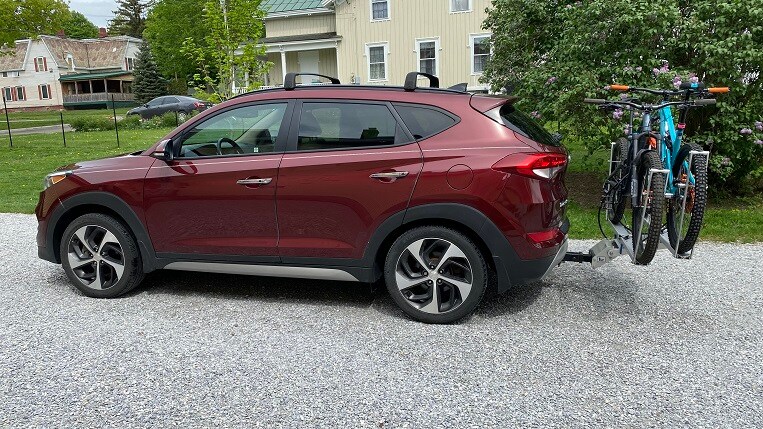
1Up bike racks work modularly, and any purchaser can add additional bike capacity later on if needed. The modular design comes in handy if you need to transport fewer bikes because you can remove the extra spaces.

Each additional bike adds almost 10 inches to the length of the bike rack, so care should be taken when maneuvering in tight spaces.
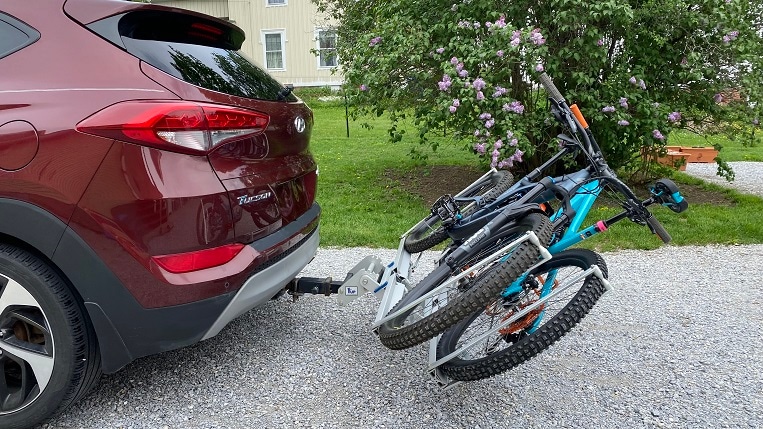
Another great feature that is a bit cumbersome to use but greatly appreciated is the multiple positions of the rack. For example, when loading up your bikes, if you need to open the trunk, you can lower the 1Up bike rack into the down position, which allows for almost wide-open access to the cargo area. You will either need to be quite strong or have a helping hand to raise and lower the 65-pound-to-250-pound bike rack.
If you’re on the taller side and need a large or extra-large bike frame, you may want to consider the maximum wheelbase of the bike rack. Some hitch bike racks offer a maximum wheelbase of 48 inches, which doesn’t cut it for transporting long-travel, full-suspension mountain bikes like the Yeti SB165. The XL-sized SB165 bike has a 50.6-inch wheelbase.
Bike Rack Total Cost: $843
1Up HD Bike Rack: $635
4 Wheel Locks: $78
12-foot Cable Lock: $54
1.25-inch to 2-inch Hitch Expander: $76
How to Load Bikes on a 1Up Bike Rack
Loading a 1Up hitch bike rack is easy and only takes a few minutes to complete. Having a high-quality bike hitch helps to protect your bike from damage and allows you to spend more time cycling. If possible, remove your bike racks to prevent extra wear and tear when not in use.
Expert Tip: Make sure that the position of the pedals won’t hit the other bike’s frame when loading and unloading. The bikes remain stable once you secure them on the rack, and you’ll get an inch of clearance even with some of the largest MTB flat pedals available.
Load your bikes in an alternating pattern to avoid handlebar interference, and adjust the seat height for the best fit. Adjusting the seat height on many mountain bikes only takes a few seconds, thanks to the glorious invention of the dropper seat post.
Steps for Loading the Bicycles
- Unfold bike rack arms
- Load bike closest to vehicle
- Load bikes in alternating order
- Insert wheel locks
- Secure bike frames with a cable lock
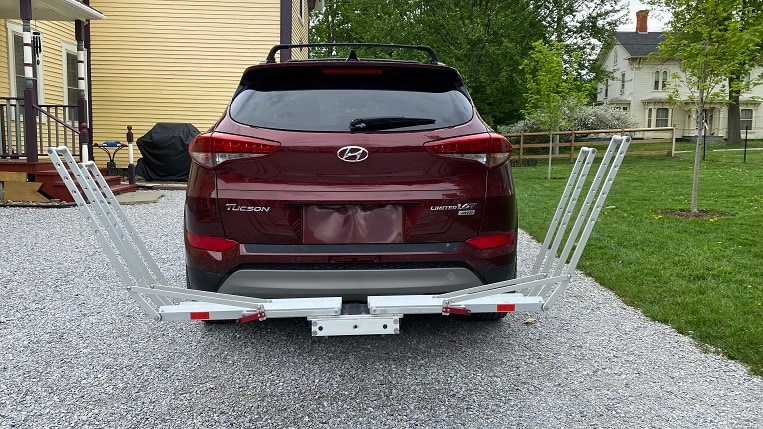
Unfold the bike rack arms.
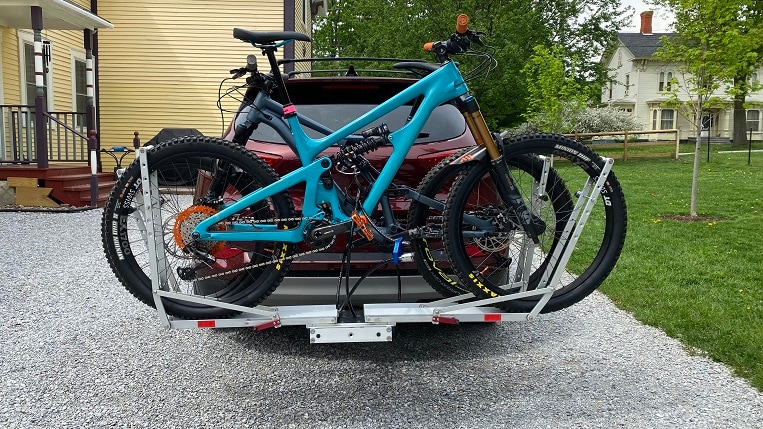
Load the first bicycle closest to the vehicle and lower the arms until they secure the tires. You can load additional bikes in an alternating seat-to-handlebar to avoid interference.
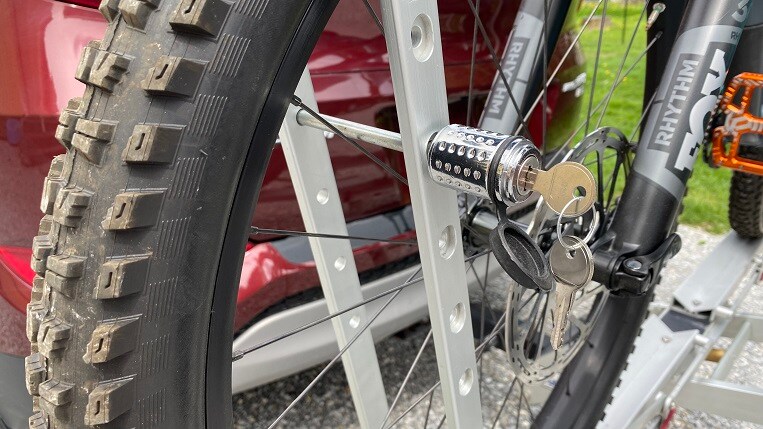
Insert wheel locks through the bike rack arms and wheel spokes.

Lock the bike frames to the bike rack using the cable lock.
Related Stories:








